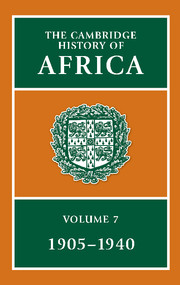Book contents
- Frontmatter
- Introduction
- 1 The imperial mind
- 2 Aspects of economic history
- 3 Christianity
- 4 Islam
- 5 African cross-currents
- 6 The Maghrib
- 7 French black Africa
- 8 British West Africa and Liberia
- 9 Belgian Africa
- 10 Portuguese Africa
- 11 Southern Africa
- 12 British Central Africa
- 13 East Africa
- 14 Ethiopia and the Horn
- 15 Egypt and the Anglo-Egyptian Sudan
- Bibliographical Essays
- Bibliography
- Index
- 10 West Africa from Senegal to Dahomey, 1935
- 13 Belgian Africa, 1939
- References
11 - Southern Africa
Published online by Cambridge University Press: 28 March 2008
- Frontmatter
- Introduction
- 1 The imperial mind
- 2 Aspects of economic history
- 3 Christianity
- 4 Islam
- 5 African cross-currents
- 6 The Maghrib
- 7 French black Africa
- 8 British West Africa and Liberia
- 9 Belgian Africa
- 10 Portuguese Africa
- 11 Southern Africa
- 12 British Central Africa
- 13 East Africa
- 14 Ethiopia and the Horn
- 15 Egypt and the Anglo-Egyptian Sudan
- Bibliographical Essays
- Bibliography
- Index
- 10 West Africa from Senegal to Dahomey, 1935
- 13 Belgian Africa, 1939
- References
Summary
By 1910, three governments held sway in southern Africa over a region as large as India and five times the size of France. The Union of South Africa, created in that year, was a self-governing Dominion in the British Empire; it brought together, under a unitary constitution, the territories of the Cape, Natal, the Orange River Colony and the Transvaal. The British government, which had thereby granted virtual independence to the white people of South Africa, retained responsibility for three adjacent protectorates: Bechuanaland, Swaziland and Basutoland. However, these were closely tied to the Union; Basutoland was a mountain enclave within it; and all three were administered by a British high commissioner who until 1931 was also governor-general of South Africa. South West Africa was a German colony, but the best harbour along its coastline, Walvis Bay, belonged to the Union, for the Cape Colony had annexed it before the Germans took over the surrounding territory.
Geographically, southern Africa encompasses huge contrasts. Its watershed, the Drakensberg range, falls abruptly to the east coast and causes monsoon rains to fall over Natal and the eastern Cape. For centuries this coastal belt had been colonised by African mixed farmers; more recently, they had been joined by British planters and Indian workers. Elsewhere, the only important regions for arable farming were parts of the northern plateaux, where Afrikaners had settled, and the south-western Cape, which enjoys a Mediterranean climate: this was the heartland of the Coloured people. Otherwise, the western two-thirds of southern Africa comprise arid grassland, scrub and desert, where annual rainfall varies from 15 inches to little or none. In 1911 there were probably well under 200,000 people in South West Africa and less than 150,000 in Bechuanaland.
- Type
- Chapter
- Information
- The Cambridge History of Africa , pp. 544 - 601Publisher: Cambridge University PressPrint publication year: 1986

